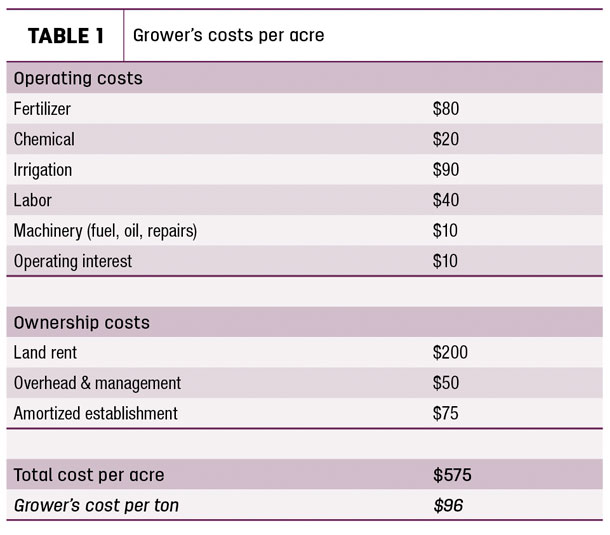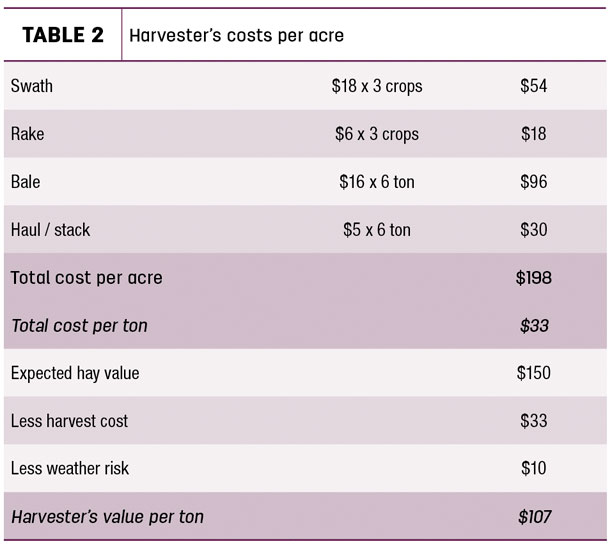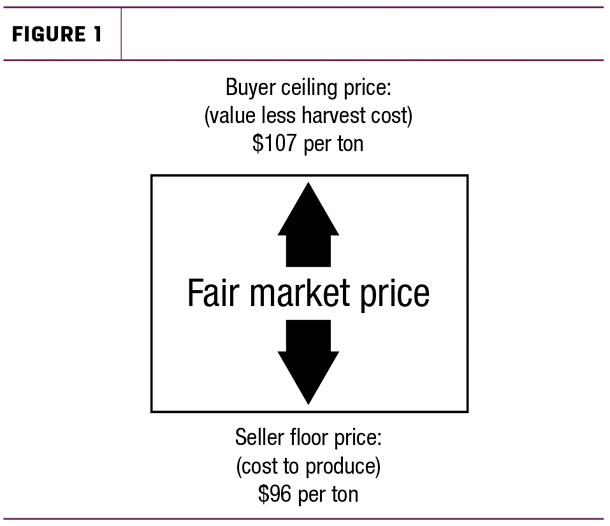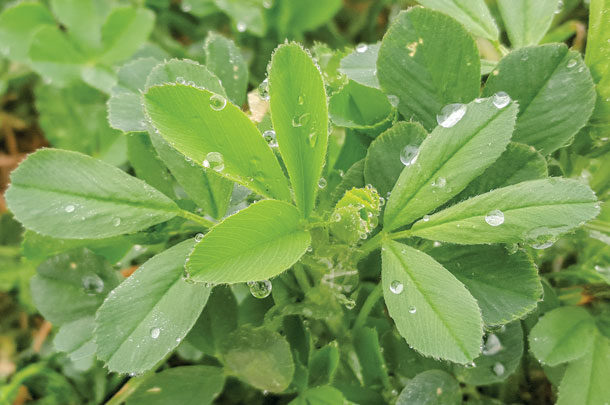Calculating those costs may take some time, but it will help both parties make a profitable decision. In this article, we’ll go through an example using a simple five-step process.
- Step 1: Estimate the grower’s costs.
- Step 2: Establish a value for the hay.
- Step 3: Determine the yield.
- Step 4: Estimate the harvester’s costs.
- Step 5: Negotiate a fair price.
First, a little background about the farm in this example: Let’s look at an irrigated farm in southern Idaho. The average yield is about 6 tons per year per acre with three cuttings.
Step 1: Estimate the grower’s costs
We need to account for all costs of production. Operating costs include fertilizer, chemicals, irrigation, labor, machinery (fuel, oil and repairs) and interest on operating capital. Ownership costs include land rent, general overhead and management, and an amortized establishment cost, which is just spreading out the new seeding establishment costs over the life of the hay stand. Table 1 is an example of the grower’s costs to produce alfalfa hay on a per-acre basis ($575 per acre) and broken down to the cost per ton ($96 per ton).

If you keep track of your own production costs and use an enterprise budget, this part is easy. If you don’t know your direct costs, you can make estimates or use the University of Idaho budgets as a starting point.
Step 2: Establish a value for the hay
The harvester needs to establish a value for the hay to be harvested. You can check a recent market report for local prices or use historical prices based upon your quality expectations. You may also want to consider the cost of weather and perhaps yield risk, and adjust your price to compensate for these factors.
For this example, let’s use an expected hay value of $150 per ton as a base and decrease that by $10 per ton to account for weather risk. Weather risk is difficult to put a price on, but it is real, and it can be costly. You’ll need to use your own judgment when it comes to placing a value on weather risk. So our estimated price will be $140 per ton. We’ll use this price to calculate how much we can afford to pay for hay on the stump in Step 4.
Step 3: Determine the yield
Yields can be estimated before harvest, or you can weigh the crop after harvest to get actual yields. Agreements can be set up based on either method. In some cases, it may be best to agree on a set percentage of the hay yield after the harvest rather than trying to estimate the yield before the harvest.
Just a word of caution when estimating yields: Be sure to convert fresh weights to a dry matter basis. For this example, we will use an estimated yield of 6 tons per acre, so we can calculate the grower’s costs and the harvester’s costs on a per-ton basis.
Step 4: Estimate the harvester’s costs
The harvester’s costs are swathing, raking, baling, hauling and stacking. You can use custom harvest rates or calculate your actual costs. These costs should include equipment depreciation, fuel, oil, lube, repairs, labor, transportation to the field, operating interest, twine and other expenses and are influenced by the amount of equipment use.
The harvester’s costs are in Table 2.

The cost to put up all three crops is $198 per acre, or $33 per ton based on a 6-ton yield. If we use the base price of $150 per ton and subtract $10 for weather risk and $33 for harvest costs, the value to the harvester is $107 per ton.
Step 5: Negotiate a fair price
After you calculate the seller’s costs to produce the hay and the buyer’s hay value minus harvest costs, you can begin negotiating a fair price. The maximum price the harvester would be willing to pay is the estimated hay value minus harvesting and risk costs. The minimum price the grower would be willing to sell at is his cost of production. You’ve established the ceiling and the floor prices.
In this simple example (Figure 1), a fair market price for hay on the stump should be somewhere between $96 and $107 per ton.

A price within this range will be a win-win for the grower and the harvester. You can use the negotiated price to establish an annual per-acre price or a per-cutting price if you need to.
Remember to put it in writing!
Finally, it’s always a good idea to put these agreements in writing just to make sure everyone is on the same page. A simple contract specifying the acreage, price, yield, payment date and other details should be enough. Good business relationships tend to last longer when we put things in writing.
This is a simple example, and results should be different for your own farm. Take a few minutes and crunch your numbers. The University of Idaho Extension has several tools that may be helpful, including crop enterprise budgets (costs and returns estimates), a custom rates guide and a machine cost calculator. These can be found on the Idaho AgBiz website. ![]()
PHOTO: Getty Images.

-
Ben Eborn
- Extension Ag Economist
- University of Idaho
- Email Ben Eborn










